आलू की फसल के 7 प्रमुख कीट पतंग और उनका प्रबंधन
The potato (Solanum tuberosum L.) is the most important crop of India. Potato is a crop of the cool, temperate regions of elevation of approximately 2000 m or more in the tropics. It requires cool nights and well drained soil with adequate moisture and does not produce well in low altitude, warm, tropical environment.
In India, potato is grown in tropics as well as in sub-tropics in the cool season. About 86% of potato crop is grown in the plains during winter under short-day conditions, about 8% in the hills during summer under long day conditions and around 6% in the plateau during the rainy season. The advantages of the potato growing over other crops are high productivity, price stability, profitability and easy market.
The main constraint to potato farming in India are: It is vulnerable to pests and diseases hence implying a high risk of failure, growing potatoes requires substantial capital and the crop needs intensive care and attention. However, a proper insect pest management program will minimise losses to potato crop
1. Potato tuber moth: Phthorimaea operculella
Marks of identification:
Potato Moths are small narrow winged greyish brown in colour, measure about 12 mm long. Full grown caterpillars are pinkish white or pale greenish in colour and 14-20 mm long.
Nature of damage by potato tuber moth
- It bores into petioles and terminal shoots
- The main danger is to tubers both in the field and under storage.
- The caterpillars bore the tubers and feed on the pupal as a result of damage the potato tubers rot.
- The presence of black excreta near the eye buds helps to detect its presence in the tubers.
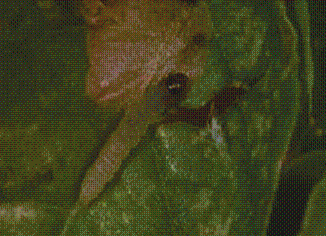
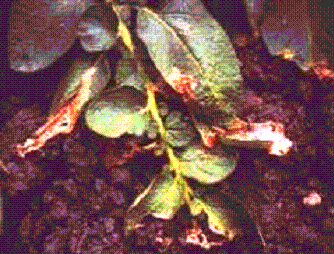
Larvae Leaf damage
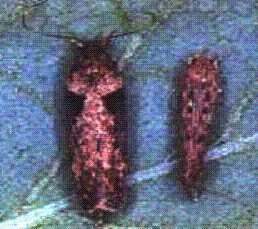
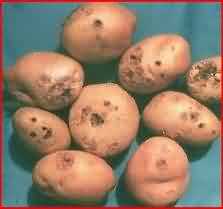
Adult Tuber damage
Management of potato tuber moth:
In field: -
- Timely earthing up of the crop to cover the exposed tubers helps in reducing the intensity of infestation.
- Two sprays with 0.05% quinalphos or 0.1% carbaryl at 15 days interval starting 60 days after planting controls the pest effectively.
- Heaps of harvested potatoes should not be kept exposed in the field but covered with straw and infested tubers should be rejected before storage.
- Release Copidosoma koehleri 50 000 adults/ha/release, Chelonius blackbernii 15000 adults/ha/release an egg-larval parasite to reduce 50-55% infestation.
- However, if harvest should be delayed and leaves have senesced, apply on the soil surface any one of the following: Lambda cyhalothrin 600 ml/ha or Indoxacarb 30 WG 130 g/ha or Runner (methoxyfenozide) 240 SC 600 ml /ha
In storage
- The potatoes should be stored in well-ventilated cool and dry places with temperature not exceeding 210C.
- Fumigate the tubers with CS2 at the rate of 1kg/27 cu.m for 48 hours at 700F or ethyl bromide at the rate of 1 kg/27 cu.m for the least three hours before storage.
- Covering of tubers with 1" layer of dry sand is stated to be a cheap and highly effective remedy against the pest
- Walls of godown should be sprayed with 1% Malathion at an interval of 3 months.
- Treatment of seed potato tubers with 5% Malathion at the rate of 125 gm/100kg is also reported to offer good protection against the pest. Such treated potatoes, however, should not be used for consumption.
- If cold storage facilities are available, the produce can be safely stored for a longer period.
2. Potato Cut worm: Agrotis ypsilon
Marks of Identification:
Potato cutworm Moth is medium sized (22-26 mm longer), stout with greyish brown wavy lines and sports on fore wings and creamy white wings. The moths are active at dusk and are attracted by light. Full grown caterpillars are 40-48 mm long dirty black in colour and have habit of coiling at slightest touch.
Nature of damage
- It damage plants and tubers, especially after dark
- They attack young plants by severing their stems, pulling all parts of the plant into the ground and devouring them particularly at 25 – 35 days after planting (DAP)
- Signs of damage on tubers are boreholes, larger than those made by potato tuber moths
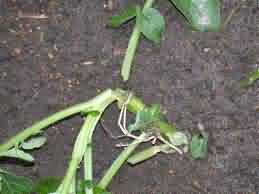
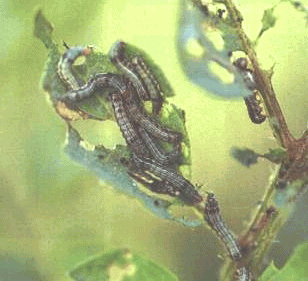
Damage during seedling stage Larvae with symptom of damage
Management of Potato cutworm:
- Heaps of green grasses may be kept at suitable interval in infested field during evening and next day early in the morning along with caterpillars to destroy
- Clean cultivation and mechanical destruction of caterpillars also help in reducing pest infestation
- Irrigation also brings them on the surface and birds shall predate them
- 5% Carbaryl poison bait at the rate of 25-60 kg/ha controls the pest effectively
- Soil application of chlordane or Heptachlor dust at the rate of 50 kg/ha found effective against the pest.
- Apply any one of the followings insecticides Coragen 20 SC 300 ml /ha or Tracer 48 SC 200 ml/ha or Indoxacarb 30 WG 130 g/ha
3. Epilachna beetle of Potato: Epilachna viginatioctopunctata
Marks of identification:
The epilachna beetles of potato are special in shape, pale brown in colour and motted with black spots. The grubs are yellow with hairs on their body
Nature of damage by epilachna beetles
- Both grub and beetle eat the chlorophyll of the leaf in between the veins and cause characteristic skeletonised patches on leaves
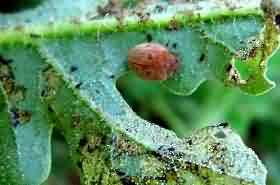
Epilachna beetle in Potato
Management of epilachna beetles
- Hand packing of grubs and collection of beetles by hand nets during early stages of attack, helps in reducing the intensity of infestation
- Conservation and augmentation of natural parasitoids viz.Pediobius foveolatus, Pleunotrogrus faveolatus andTetrastichus sp
- Application of Neem, Mahua, ground nut cakes are efficient in suppressing the pest population
- Spray of Malathion 50 EC in 200 liters of water per acre provides up to 82 percent kill of this pest
4. Aphids in potato: Myzus persicae
Marks of Identification:
Aphids are tiny yellowish soft-bodied insects, the adult is along 1mm long and has two projections called cornicles on the dorsal side of abdomen
Nature of damage by Aphids
Direct damage:
- It puncturing them and sucking their juices.
- They damage the young and soft parts of plants, such as new leaves and shoots.
- Signs of damage are leaves not opening properly and being smaller in size.
- Severe infestation can cause shoots to wilt and dry out.
Indirect damage:
- Aphids have wings and can move from plant to plant spreading viral diseases (potato virus Y and potato leaf roll virus), picked up from infected plants
- Aphids secrete a sugary liquid that stimulates black sooty mold growth. It can cover the surface of leaves which affects the way they absorb sunlight
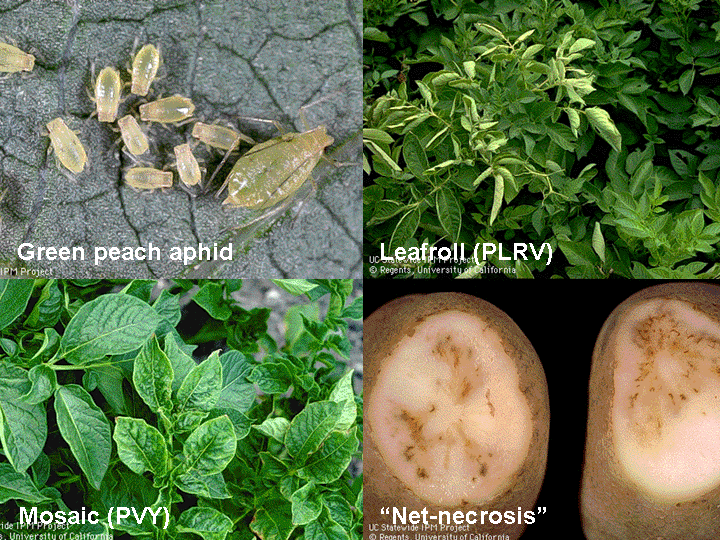
Management of Aphids in Potato
- Apply any one of the following insecticides Actara (thiamethoxam) 25 WG 600 g/ha in the furrows at planting or spray Confidor (imidacloprid) 70 WG 125 g/ha or Actara 25 WG 80 g/ha after 6 weeks
- In case of seed crop, apply 5 kg of Thimet 10G (phorate) to the soil at the time of the first earthing up
- Encourage the activity of Dieretella spp, Ahelinus and Ahidius parasitoids and ladybird beetles and syrphid predators
5. Jassids of Potato: Empoasca fabae:
Marks of Identification:
The adults are greenish yellow with front wings having a black spot on each, at the apical margin and two black spots on the vertex of the head. The nymphs are also green. They walk diagonally.
Nature of damage by Jassids in potato crop
- Both nymphs and adult suck the sap from the lower surface of the leaves
- The damaged leaves curl upwards along the margins and turn yellowish and show burnt patches. This affect adversely plant growth and yield
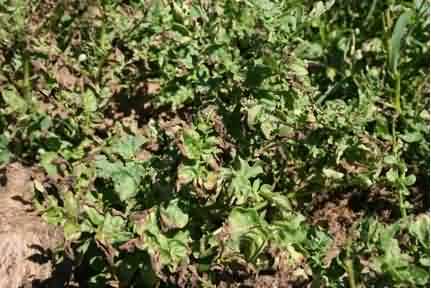
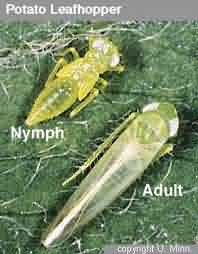
Hopper burn symptoms – burnt patches
Management of Jassids in potato
- Seed treatment with imidacloprid (Gaucho) or Cruiser @ 5 grams per kg seed. In the field, spray with imidacloprid @ 1 ml in 3-4 liters of water or fipronil @ 2 ml per liter.
- Spray the crop with 300 ml of Rogor 30EC (dimethoate) or metasystox 25EC (methyl-demeton) or 75 ml of dimecran 85SL ( phosphomidon) in 80-100 liters of water per acre. If necessary repeat the spray after 10 days.
6. Thrips of potato: Helicothrips indicus:
Marks of Identification:
The adults are minute, delicate insects, less than 1 mm long and are light yellow in colour. Wings have fringe or hairs throughout and hence they are called fringed, winged insects. The nymphs are still smaller, minute and wingless.
Nature of damage by thrips in potato
Direct damage:
- It damage the undersides of leaves by scrape the epidermis and such the oozing sap
- They damage young and soft parts of plants such as new leaves and shoots
- As a result, leaves curl downwards and change to a blackish- silver color
- Severe infestation causes young leaves to wilt and dry out
Indirect damage:
- It can carry and spread spotted wilt virus diseases
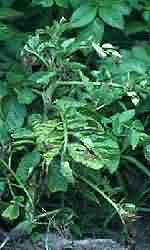
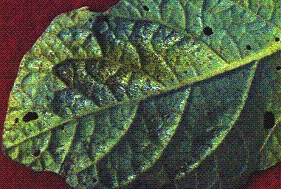
Spotted wilt virus Thrips underside of leaves
Management of Thrips of potato
- Spraying with Tracer (spinosad) 48 SC 300 ml/ha or 0.02% phosphamidon, 0.03% dimethoate, methyl demeton or thiometon control the pest effectively.
- In the field, spray with imidacloprid @ 1 ml in 3-4 liters of water or fipronil @ 2 ml per liter.
- Sufficient watering – Thrips thrive in dry conditions and watering will increase moisture and inhibit their development.
- Using black silver mulch – Light reflected from the silvery surface illuminating the undersides of leaves can repel thrips.
7. White grub of potato:
Marks of Identification:
White grubs are the larval form of beetles. They are large reaching 2-3 cm in length, are shaped like the letter C, and have three pairs of legs on their thorax. Their heads are hard and ruddy-brown in color, and they have strong mandibles.
Nature of damage by White grub of potato
- Tubers damaged by irregular holes. More than two holes are often found in one tuber.
- These holes are not so deep, as white grubs do not enter and live inside tubers.
- Severe infestations usually occur in fields previously covered with grasses.
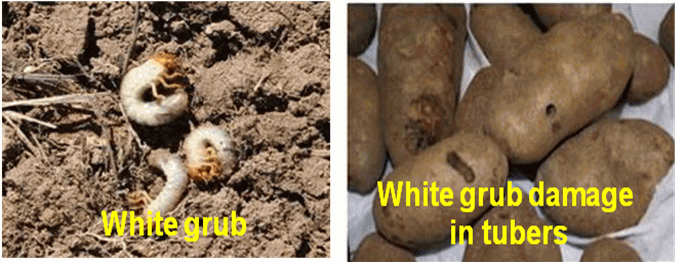
Management of white grub of potato
- Collecting larvae when tilling soil, planting, weeding and hilling up.
- Avoiding using un composted organic fertilizer, as it is a suitable breeding ground for this pest.
- Avoiding to plant potatoes in fields that were previously covered with grasses.
- Flooding field prior to planting, Where possible farmers can consider temporarily flooding fields, particularly on severely infested fields.
- Making use of bird predators to reduce white grub populations.
Reference
- Widagdo, H. and J. W. Ketelaar (Editors) 2006. A Handbook to the Ecology and Integrated Management of Potato. International Potato Center & FAO Regional Vegetable IPM Program in South and Southeast Asia. Pp. 41.
- Vasantharaj David, B. and Ramamurthy, V.V, 2011. Elements of Economic Entomology. Namrutha Publications, Chennai.
Authors:
S. Selvaraj1* and P. Ganeshamoorthi2
1 Department of Entomology, G.B. Pant University of Agrl. & Tech., Pantnagar – 263145
*Email:
2Division of Plant Pathology, IARI, New Delhi – 110012,
Email:
